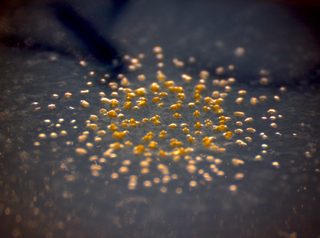
Bacterial conjugation is the transfer of genetic material between bacterial cells by direct cell-to-cell contact or by a bridge-like connection between two cells. This takes place through a pilus. It is a parasexual mode of reproduction in bacteria.

The myxobacteria are a group of bacteria that predominantly live in the soil and feed on insoluble organic substances. The myxobacteria have very large genomes relative to other bacteria, e.g. 9–10 million nucleotides except for Anaeromyxobacter and Vulgatibacter. One species of myxobacteria, Minicystis rosea, has the largest known bacterial genome with over 16 million nucleotides. The second largest is another myxobacteria Sorangium cellulosum.

Horizontal gene transfer (HGT) or lateral gene transfer (LGT) is the movement of genetic material between organisms other than by the ("vertical") transmission of DNA from parent to offspring (reproduction). HGT is an important factor in the evolution of many organisms. HGT is influencing scientific understanding of higher-order evolution while more significantly shifting perspectives on bacterial evolution.

Pseudomonas fluorescens is a common Gram-negative, rod-shaped bacterium. It belongs to the Pseudomonas genus; 16S rRNA analysis as well as phylogenomic analysis has placed P. fluorescens in the P. fluorescens group within the genus, to which it lends its name.

Streptomyces is the largest genus of Actinomycetota, and the type genus of the family Streptomycetaceae. Over 700 species of Streptomyces bacteria have been described. As with the other Actinomycetota, streptomycetes are gram-positive, and have very large genomes with high GC content. Found predominantly in soil and decaying vegetation, most streptomycetes produce spores, and are noted for their distinct "earthy" odor that results from production of a volatile metabolite, geosmin. Different strains of the same species may colonize very diverse environments.

Halobacterium is a genus in the family Halobacteriaceae.

Myxococcus xanthus is a gram-negative, bacillus species of myxobacteria that is typically found in the top-most layer of soil. These bacteria lack flagella; rather, they use pili for motility. M. xanthus is well-known for its predatory behavior on other microorganisms. These bacteria source carbon from lipids rather than sugars. They exhibit various forms of self-organizing behavior in response to environmental cues. Under normal conditions with abundant food, they exist as predatory, saprophytic single-species biofilm called a swarm, highlighting the importance of intercellular communication for these bacteria. Under starvation conditions, they undergo a multicellular development cycle.

Epothilones are a class of potential cancer drugs. Like taxanes, they prevent cancer cells from dividing by interfering with tubulin, but in early trials, epothilones have better efficacy and milder adverse effects than taxanes.

Bacteria are ubiquitous, mostly free-living organisms often consisting of one biological cell. They constitute a large domain of prokaryotic microorganisms. Typically a few micrometres in length, bacteria were among the first life forms to appear on Earth, and are present in most of its habitats. Bacteria inhabit soil, water, acidic hot springs, radioactive waste, and the deep biosphere of Earth's crust. Bacteria play a vital role in many stages of the nutrient cycle by recycling nutrients and the fixation of nitrogen from the atmosphere. The nutrient cycle includes the decomposition of dead bodies; bacteria are responsible for the putrefaction stage in this process. In the biological communities surrounding hydrothermal vents and cold seeps, extremophile bacteria provide the nutrients needed to sustain life by converting dissolved compounds, such as hydrogen sulphide and methane, to energy. Bacteria also live in mutualistic, commensal and parasitic relationships with plants and animals. Most bacteria have not been characterised and there are many species that cannot be grown in the laboratory. The study of bacteria is known as bacteriology, a branch of microbiology.

Ixabepilone is a pharmaceutical drug developed by Bristol-Myers Squibb as a chemotherapeutic medication for cancer.
Plant transformation vectors are plasmids that have been specifically designed to facilitate the generation of transgenic plants. The most commonly used plant transformation vectors are T-DNA binary vectors and are often replicated in both E. coli, a common lab bacterium, and Agrobacterium tumefaciens, a plant-virulent bacterium used to insert the recombinant DNA into plants.

A prokaryote is a single-cell organism whose cell lacks a nucleus and other membrane-bound organelles. The word prokaryote comes from the Ancient Greek πρό 'before' and κάρυον 'nut, kernel'. In the two-empire system arising from the work of Édouard Chatton, prokaryotes were classified within the empire Prokaryota. But in the three-domain system, based upon molecular analysis, prokaryotes are divided into two domains: Bacteria and Archaea. Organisms with nuclei are placed in a third domain, Eukaryota.
Stigmatella aurantiaca is a member of myxobacteria, a group of gram-negative bacteria with a complex developmental life cycle.

Latilactobacillus sakei is the type species of the genus Latilactobacillus that was previously classified in the genus Lactobacillus. It is homofermentative; hexoses are metabolized via glycolysis to lactic acid as main metabolite; pentoses are fermented via the Phosphoketolase pathway to lactic and acetic acids.

Lactocillin is a thiopeptide antibiotic which is encoded for and produced by biosynthetic genes clusters in the bacteria Lactobacillus gasseri. Lactocillin was discovered and purified in 2014. Lactobacillus gasseri is one of the four Lactobacillus bacteria found to be most common in the human vaginal microbiome. Due to increasing levels of pathogenic resistance to known antibiotics, novel antibiotics are increasingly valuable. Lactocillin could function as a new antibiotic that could help people fight off infections that are resistant to many other antibiotics.

Utidelone is a pharmaceutical drug for the treatment of metastatic breast cancer. It was approved for use in China in 2021.
Enhygromyxa salina is a species of marine myxobacteria. Like other members of this order, E. salina is a rod-shaped Gram-negative bacterium that can move by gliding and can form aggregates of cells called fruiting bodies. E. salina is slightly halophilic (salt-tolerant) and can grow at lower temperatures than other marine myxobacteria. Several novel secondary metabolites have been identified in the species, including unusual sterols. The species was first described in 2003, based on six strains isolated from samples collected from the coastlines of Japan.

Chlorotonil A is a polyketide natural product produced by the myxobacterium Sorangium cellulosum So ce1525. It displays antimalarial activity in an animal model, and has in vitro antibacterial and antifungal activity. The activity of chlorotonil A has been attributed to the gem-dichloro-1,3-dione moiety, which is a unique functionality in polyketides. In addition to its unique halogenation, the structure of chlorotonil A has also garnered interest due to its similarity to anthracimycin, a polyketide natural product with antibiotic activity against Gram-positive bacteria.

Disorazol, a cyclic polyketide synthesized by the bacterium Sorangium cellulosum So ce12, was first detected and isolated in 1994. Its chemical structure consists of a macrocyclic ring and two oxazole rings. Disorazol A has been demonstrated to exhibit anti-fungi activities, but it was not active against yeasts. In addition, this substance demonstrates potent anti-cancer characteristics at exceptionally low picomolar levels by obstructing the mechanism of tubulin assembly and triggering the disruption of microtubules. As a result, these impacts lead to the initiation of cell apoptosis. However, disorazols cannot be directly used as drugs in the clinic due to its extremely high cytotoxicity and instability. Thus, chemical and biosynthetic synthesis pathways were designed to synthesize unnatural derivatives of disorazol in hope of reducing its cytotoxicity without decreasing its anti-cancer potency.
Tartrolons are a group of boron-containing macrolide antibiotics discovered in 1994 from the culture broth of the myxobacterium Sorangium cellulosum. Two variants of tartrolons, A and B, were identified. Tartrolon B contains a boron atom, while tartrolon A does not.















